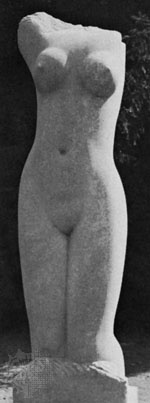Gill, (Arthur) Eric (Rowton)
British artist and printer
born Feb. 22, 1882, Brighton, Sussex, Eng.
died Nov. 17, 1940, Uxbridge, Middlesex
British sculptor, engraver, typographic designer, and writer, especially known for his elegantly styled lettering and typefaces and the precise linear simplicity of his bas-reliefs.
 Gill spent two years in an art school in Chichester and in 1899 was articled to a London architect; in 1902 he turned to letter carving after studying in his spare time at the new Central School of Arts and Crafts with Edward Johnston, a pioneer in the revival of lettering. From then until 1910, he worked as a carver of tombstones, although by 1909 he had turned to figure sculpture. “Mother and Child” (1912) brought him public notice. After 1912 his success as a sculptor was established, and he inspired an English revival of direct carving in stone rather than using preparatory clay models. He carved the stations of the cross for Westminster Cathedral (1914–18), London; these bas-reliefs and his famous torso “Mankind” (1928) were cut in Hoptonwood stone, which he helped make fashionable in the 1920s and '30s. Other major commissions included the relief “Prospero and Ariel” over the main entrance of Broadcasting House, London (1931), and the three bas-reliefs entitled “The Creation of Adam” (1935–38) in the lobby of the council hall of the Palace of Nations at Geneva.
Gill spent two years in an art school in Chichester and in 1899 was articled to a London architect; in 1902 he turned to letter carving after studying in his spare time at the new Central School of Arts and Crafts with Edward Johnston, a pioneer in the revival of lettering. From then until 1910, he worked as a carver of tombstones, although by 1909 he had turned to figure sculpture. “Mother and Child” (1912) brought him public notice. After 1912 his success as a sculptor was established, and he inspired an English revival of direct carving in stone rather than using preparatory clay models. He carved the stations of the cross for Westminster Cathedral (1914–18), London; these bas-reliefs and his famous torso “Mankind” (1928) were cut in Hoptonwood stone, which he helped make fashionable in the 1920s and '30s. Other major commissions included the relief “Prospero and Ariel” over the main entrance of Broadcasting House, London (1931), and the three bas-reliefs entitled “The Creation of Adam” (1935–38) in the lobby of the council hall of the Palace of Nations at Geneva.He and Douglas Pepler founded St. Dominic's Press in 1915. Gill contributed wood engravings and lettering for the press and also began his provocative writings on the relationship of religion to the workman and to art. In 1924 he was asked to do engravings for the Golden Cockerel Press; the best remembered of his hundreds of engravings and dozens of books is the Four Gospels (1931), printed from type expressly designed by him for the press. At this time he formed, with his son-in-law René Hague, a private press at his home in Pigotts where in 1931 he printed his controversial essay, “Typography.”
Typefaces he designed included Perpetua (1925), Gill Sans Serif (1927), Joanna (1930), and Bunyan, designed in 1934 but recut for machine use and renamed Pilgrim in 1953.
Gill was made an associate of the Royal Academy in 1937 and of the Royal Society of British Sculptors in 1938. His books include Christianity and Art (1927), Work and Property (1937), and Autobiography (1940).
Additional Reading
Biographies include Malcolm Yorke, Eric Gill, Man of Flesh and Blood (1981); and Fiona MacCarthy, Eric Gill (1989).
- Baron Sydenham, Charles Poulett Thomson
- Baron Tanaka Giichi
- Baron Todd, Alexander Robertus Todd
- baron van Coehoorn, Menno
- baron van der Capellen, Godert Alexander Gerard Philip
- Baron van Hoëvell, Wolter Robert
- baron van Imhoff, Gustaaf Willem
- Baron Vansittart, Robert Gilbert Vansittart
- Baron von Beck, Max Wladimir
- baron von der Goltz, Colmar
- Baron von Eötvös, Roland
- Baron von Görtz, Georg Heinrich
- Baron von Haymerle, Heinrich
- Baron von Humboldt, Wilhelm
- Baron Von Hügel von Hügel, Friedrich
- Baron von Ketteler, Wilhelm Emmanuel
- Baron von Liliencron, Detlev
- Baron von Neurath, Konstantin
- Baron von Reuter, Paul Julius
- Baron von Seydlitz, Friedrich Wilhelm
- Baron von Slatin, Rudolf Karl
- Baron von Stockmar, Christian Friedrich
- Baron Wakefield, William Wavell Wakefield
- Baron Wilson Of Rievaulx Wilson, Harold
- Baron Wrangel, Pyotr Nikolayevich